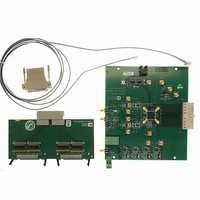AD9779A-EBZ Analog Devices Inc, AD9779A-EBZ Datasheet - Page 41

AD9779A-EBZ
Manufacturer Part Number
AD9779A-EBZ
Description
Dual 16B, 1.0 GSPS TxDAC
Manufacturer
Analog Devices Inc
Series
TxDAC®r
Datasheet
1.AD9776ABSVZ.pdf
(60 pages)
Specifications of AD9779A-EBZ
Design Resources
Interfacing ADL5370 to AD9779A Dual-Channel, 1 GSPS High Speed DAC (CN0016) Interfacing ADL5371 to AD9779A Dual-Channel, 1 GSPS High Speed DAC (CN0017) Interfacing ADL5372 to AD9779A Dual-Channel, 1 GSPS High Speed DAC (CN0018) Interfacing ADL5373 to AD9779A Dual-Channel, 1 GSPS High Speed DAC (CN0019) Interfacing ADL5374 to AD9779A Dual-Channel, 1 GSPS High Speed DAC (CN0020) Interfacing ADL5375 to AD9779A Dual-Channel, 1 GSPS High Speed DAC (CN0021)
Number Of Dac's
2
Number Of Bits
16
Outputs And Type
2, Differential
Sampling Rate (per Second)
1G
Data Interface
Serial
Dac Type
Current
Voltage Supply Source
Analog and Digital
Operating Temperature
-40°C ~ 85°C
Utilized Ic / Part
AD9779A
Lead Free Status / RoHS Status
Lead free / RoHS Compliant
Settling Time
-
Lead Free Status / RoHS Status
Lead free / RoHS Compliant
LO FEEDTHROUGH COMPENSATION
The LO feedthrough compensation is the most complex of all
three operations. This is due to the structure of the offset aux-
iliary DACs, as shown in Figure 77. To achieve LO feedthrough
compensation in a circuit, each of four outputs of these AUX
DACs must be connected through a 50 Ω resistor to ground
and through a 250 Ω resistor to one of the four quadrature
modulator signal inputs. The purpose of these connections is
to drive a very small amount of current into the nodes at the
quadrature modulator inputs, therefore adding a slight dc bias
to one or the other of the quadrature modulator signal inputs.
This can be seen in the schematics for the AD9776A/AD9778A/
AD9779A evaluation board (see Figure 106).
To achieve LO feedthrough compensation, the user should start
with the default conditions of the AUX DAC sign registers, and
then increment the magnitude of one or the other AUX DAC
output currents. While this is being done, the amplitude of the
LO feedthrough at the quadrature modulator output should be
sensed. If the LO feedthrough amplitude increases, try either
changing the sign of the AUX DAC being adjusted, or adjusting
the output current of the other AUX DAC. It may take practice
before an effective algorithm is achieved.
AD9779A
25Ω TO 50Ω
I DAC
Figure 79. Typical Use of Auxiliary DACs DC Coupling to Quadrature
I OR Q DAC
AD9779A
Figure 78. Typical Use of Auxiliary DACs AC Coupling to
25Ω TO 50Ω
0.1µF
0.1µF
AD9779A
25Ω TO 50Ω
Q DAC
Modulator with DC Shift
FILTERING
OPTIONAL
Quadrature Modulator
PASSIVE
FILTERING
AUX DAC1
AUX DAC2
OPTIONAL
AD9779A
PASSIVE
MODULATOR V+
OR
QUADRATURE
0.1µF
0.1µF
MODULATOR V+
QUADRATURE
FILTERING
OPTIONAL
AD9779A
PASSIVE
QUAD MOD
I INPUTS
DAC1
AUX
25Ω TO 50Ω
QUAD MOD
I OR Q INPUTS
MODULATOR V+
QUADRATURE
AD9779A
QUAD MOD
Q INPUTS
DAC2
AUX
Rev. A | Page 41 of 60
Using the AD9776A/AD9778A/AD9779A evaluation board, the
LO feedthrough can typically be adjusted down to the noise
floor, although this is not stable over temperature.
RESULTS OF GAIN AND OFFSET CORRECTION
The results of gain and offset correction can be seen in Figure 80
and Figure 81. Figure 80 shows the output spectrum of the quad-
rature demodulator before gain and offset correction. Figure 81
shows the output spectrum after correction. The LO feedthrough
spur at 2.1 GHz has been suppressed to the noise level. This
result can be achieved by applying the correction, but the correc-
tion needs to be repeated after a large change in temperature.
Note that the gain matching improved the negative frequency
image rejection, but there is still a significant image present.
The remaining image is now due to phase mismatch in the
quadrature modulator. Phase mismatch can be distinguished
from gain mismatch by the shape of the image. Note that the
image in Figure 80 is relatively flat and the image in Figure 81
slopes down with frequency. Phase mismatch is frequency
dependent, so an image dominated by phase mismatch has
this sloping characteristic.
Figure 81. AD9779A and ADL5372 with a Multitone Signal at 2.1 GHz, Gain
Figure 80. AD9779A and ADL5372 with a Multitone Signal at 2.1GHz, No
–100
–100
–10
–20
–30
–40
–50
–60
–70
–80
–90
–10
–20
–30
–40
–50
–60
–70
–80
–90
0
0
REF LVL
0dBm
CENTER 2.1GHz
REF LVL
0dBm
CENTER 2.1GHz
and LO Compensation Optimized
AD9776A/AD9778A/AD9779A
Gain or LO Compensation
RBW
VBW
SWT
RBW
VBW
SWT
20MHz
20MHz
3kHz
3kHz
56s
20kHz
20kHz
1.25s
REF ATT
MIXER
UNIT
REF ATT
MIXER
UNIT
SPAN 200MHz
SPAN 200MHz
30dB
–40dBm
dBm
20dB
–40dBm
dBm












